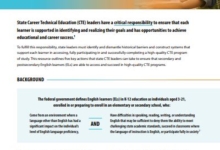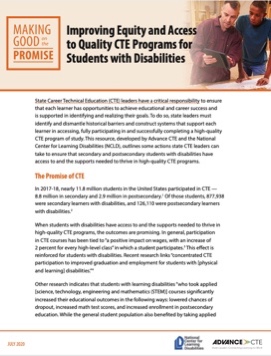In 2017-18, nearly 11.8 million students in the United States participated in Career Technical Education (CTE) — 8.8 million in secondary and 2.9 million in postsecondary. Of those students, 877,938 were secondary learners with disabilities, and 126,110 were postsecondary learners with disabilities. When students with disabilities have access to and the supports needed to thrive in high-quality CTE programs, the outcomes are promising. CTE participation is linked to improved graduation and employment for students with physical and learning disabilities. However, state leaders still face challenges when attempting to equitably serve students with disabilities. This resource from the National Center for Learning Disabilities (NCLD) and Advance CTE outlines five actions state CTE leaders can take to ensure that secondary and postsecondary students with disabilities have access to and the supports needed to thrive in high-quality CTE programs:
- Leverage the Strengthening Career and Technical Education for the 21st Century Act (Perkins V) to ensure that secondary and postsecondary learners with disabilities have access to high-quality CTE programs and instruction;
- Ensure that systems are in place to provide high-quality career guidance and advisement to secondary and postsecondary learners with disabilities;
- Leverage data to identify and close equity gaps;
- Provide professional development to staff, instructors and support personnel; and
- Ensure that learners with disabilities have access to high-quality work-based learning opportunities.
A useful resource for state leaders invested in promoting equitable outcomes for students with disabilities, this resource examines how Delaware identifies and closes equity gaps for students with disabilities.
This resource is part of the Making Good on the Promise series, which confronts the negative aspects of CTE’s legacy and defines the key challenges learners face today. The series provides promising solutions to help state leaders close equity gaps in CTE to ensure that each learner is able to attain the promise of CTE — a high-skill, high-wage, in-demand career. This resource was developed with support from the Bill & Melinda Gates Foundation.






